

Betony (Stachys betonica or Betonica officinalis)
Folk Names: Bishopwort, Lousewort, Purple Betony, Wood Betony
Description: Betony is a woodland perennial common to old European gardens, meadows, sunny slopes, and forest paths. It may be listed under Stachys betonica or Betonica officinalis. The hairy, furrowed, quadrangular stem is unbranched or slightly branched and six inches to two feet high. It rises from a thick, woody root. The stalkless leaves are hairy on both sides and appear singly at wide intervals along the stem. The more numerous basal leaves are oblong-cordate, while the upper leaves along the stem are more lanceolate. All the leaves are dotted with glands, containing a bitter, aromatic oil. Two lipped flowers in dense whorls of vivid red-purple spring up from interrupted spikes in June and August. Between each cluster of whorls is a space of bare stem, with two or four oblong leaves, then more flowers. Four smooth, brown, three-cornered nutlets develop from each fertilized flower.
Effects: strong
Planet: Jupiter, Mars, Venus Zodiac: Cancer, Sagittarius
Element: fire
Associated Deities:
Traditions:
Betony is traditionally included in midsummer fires. It is the custom to jump through the flames to purify yourself of all ills and evils for the following year. According to some sources however, it should be harvesting August, without the use of iron, so any betony used in the midsummer fires would have to be nearly a year old.
It was once planted near churches and graveyards due to its power against evil spirits. It was said if two serpents were placed in a ring made of betony, they would fight and kill each other.
During the Middle Ages, lore said it betony was a favorite of wounded animals. They would seek it out and eat it to heal their wounds. It is perhaps for this reason that the fuzzy leaves were used in field dressings of wounds.
Magic:
Placed under the pillow, betony will prevent visions and dreams.
Betony may be added to all purifying and protective mixtures and incenses. It provides protection from evil, negativity, fears, and personal demons. Grow it in garden to protect the home, and scatter near doors and windows to prevent evil spirits and witches from entering.
Carry betony when seeking love, and add it to food to reunite a quarreling couple.
Betony strengthens the body when worn, and is said to cure "elf-sickness," a medieval reference to stroke. Its power over headaches was well known in the past. Gerard credited it with plague prevention.
Known Combinations:
Betony was considered a cure for drunkenness or a preventative. Take it powdered with Colewort (Avens), as much as will fit on a 6-pence, while fasting to cure inebriation, or prevent it by carrying it as a charm.
Medical Indications: Parts Used : flowering herb, leaves
Betony is an anthelmintic, astringent, carminative, diuretic, expectorant, and vulnerary. A poultice from the root is good for external swelling, and a tea may be used on internal swelling. You can also use boiled leaves as a poultice for sprains. The juice is said to heal cuts, external ulcers, and old sores, and it may be use regularly on varicose veins. Place some betony near a toothache to relieve the pain.
Internally, betony has been used for asthma, bronchitis, and heartburn. It stimulates the heart and helps cardiovascular disorders, relaxes muscles, and reduces hyperactivity. An infusion may be used for neuralgia, bladder and kidney problems, spitting blood, and excessive sweating. Gerard recommends a decoction for worms.
Nutrition:
none
Mercantile Uses:
None aside from use as a garden plant.